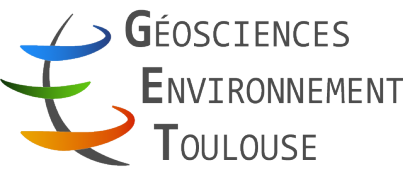Leaders
Roland MARTIN (IR CNRS, ER3), Marc BLANCHARD (DR CNRS, ER8)
Scientific objectives
To remove technological barriers and to better model certain physical phenomena at different scales of time and space, the modeling axis has different vocations:
- Interact, exchange, collaborate, and set up transverse projects in physical-digital modeling for integrated models of the Earth system at different time and space scales (from one day to millions of years), from the near-surface to the lithospheric scales and the couplings with the atmosphere and the oceans.
- Seminars on methods and study objects in terms of modeling and data processing, in connection with the “Modeling and databases of the OMP” department.
- Identify technological and methodological barriers in certain scientific themes at different levels of expertise (users and/or developers)
- Disseminate the expertise of researchers via training courses at GET (Examples: OpenFoam/L.Orgogozo, GIS/Y. Auda, Arcgis/V. Regard, etc.).
- Mapping and assessment of skills and resources (human resources, calculation codes, visualization software, and computer resources).
- Identification of needs and requests for resources.
- Active participation of the Modeling Axis in the setting up of the 3IA Artificial Intelligence Institute project “ANITI” via the IP6 integrative project: “AI for a sustainable planet: from monitoring to integrated resource management”.
Scientific themes
(Non)supervised learning, statistical analysis, and GIS (Y. Auda)
The analysis and in particular the classification of data, including multivariate analyses qualified as dual (projection into vector spaces of rows and columns), and the associated techniques are currently listed under the term Artificial Intelligence (machine learning, deep learning). The modeling axis uses all of these methods and adapts them to best answer the questions of GET researchers, particularly in the context of National Observation Services (NOS). This effort to find the most appropriate method leads to the use or implementation of various techniques in the context of multivariate analysis, such as decentralized PCA, co-inertia analysis, Partial Least Square Analysis, and, in the context of AI, random forest classification to classify land use from time series of satellite images, neural networks to determine the ecological niche of a plant from climate records or to calibrate turbidity/color curves in water. For example, to study the infestation of ragweed or the epidemiology of a Burkhoderia bacterium from a bibliographic corpus, using a disambiguation and automatic alignment methodology based on an unsupervised machine learning approach is also an avenue of research for the coming years. These methods could also be applied in geophysics.
Thermomechanical modeling of the lithosphere (M. Gerbault)
An important issue in thermo-mechanical models is that they can account for deformation processes and behaviour at the sub-scale, in particular fluid transfers in porous media, in areas of localized deformation via hydro-fracturing or shear slip. This concerns material transfers from the mantle to the surface, including intrusive and eruptive volcanic contexts, as well as elemental fractionation leading to the concentration of minerals of economic interest. To this end, we will search for a formalism representative of significant scale jumps, combining direct and inverse numerical approaches, testing methods such as phase fields at interfaces between domains of heterogeneous behavior, and confronting them with data from structural petrology, geophysics, and rock mechanics.
Modelling and geophysical imaging (R. Martin)
To better assess the seismic hazard or the energy resources of the subsurface, it is crucial to have access to the properties of the environment, to its mineralogical and thermal composition. For this purpose, it is necessary to image the geological structures and their fluid saturation rates. We will accentuate our efforts in the development of imaging techniques based on joint inversions of various data corresponding to different physics and adapted to the studied space-time scales. These tools will be applied within 5 years to the mountain and lithosphere scales (gravimetry and seismic in the Pyrenees or the Andes) up to the near-surface and the critical zone (seismic, electrical resistivity, micro-gravimetry, …). Moreover, to introduce massive data of good quality, deep learning techniques will be used, and to estimate the uncertainties on the models a priori and a posteriori, classification techniques by supervised hybrid machine learning will be performed. In the long term, a temporal follow-up of the fluids is also envisaged. Various techniques (finite elements, finite volumes, high-order finite differences, …) will be used and carried out on high-performance computing platforms (local to European Tier-0).
Coupled modeling of relief, basins, alteration, and climate (S. Carretier, D. Rouby, Y. Goddéris)
Concerning the modeling of continental paleo-surfaces, we will rely on recently developed models to understand the variations of sedimentary and dissolved fluxes from the scale of a mountain (CIDRE), of a continent (FASTSCAPE) to the whole Earth (GEOCLIM). We will progressively incorporate biota in these models, and paleoenvironmental tracers to link the evolution of continental surfaces with sedimentary records in ocean basins.
Modeling in hydrology (L. Boithias)
The objective of the transfer modeling activity (mainly OpenFOAM and SWAT) is to develop the current codes towards greater integration in terms of hydrological processes (surface, sub-surface, land use, snow cover, contaminants). For the mechanistic models RichardsFOAM and permaFOAM, one objective is also the porting to European supercomputers (tier-0).
Atomistic modeling (M. Blanchard)
Our atomistic modeling activity aims at reproducing the fundamental mechanisms governing the distribution of chemical elements and their isotopes in natural systems. In this field, an important issue will be to develop the modeling of liquids ranging from aqueous solutions to magmas, and beyond that of processes taking place at the mineral-solution interfaces. We will base our work on the Quantum Espresso code and other complementary ab initio codes, and we will try to explore the potentialities of GPU technology.

